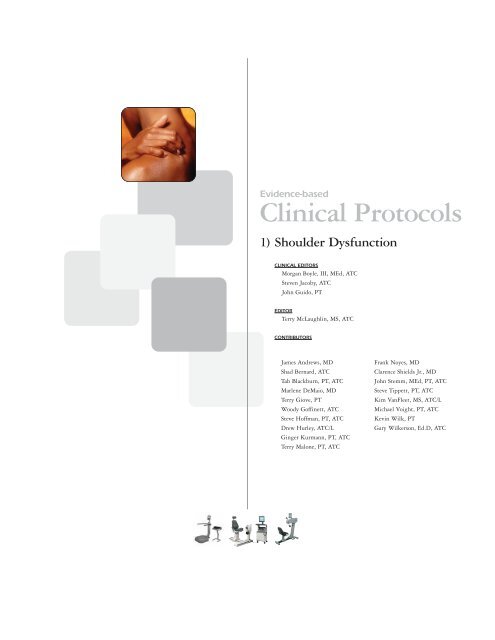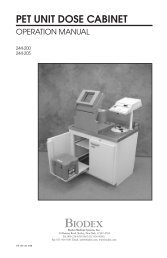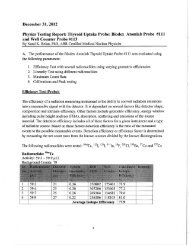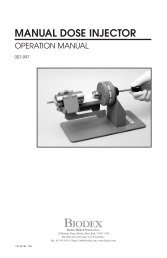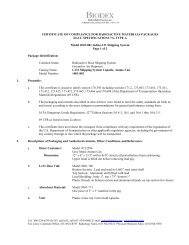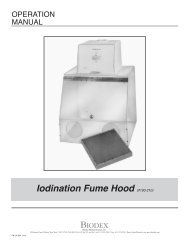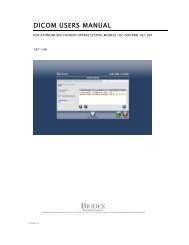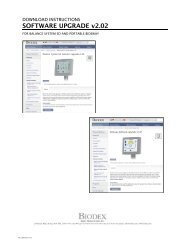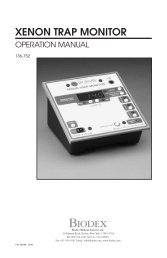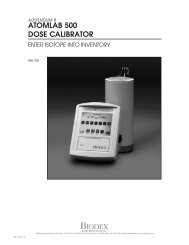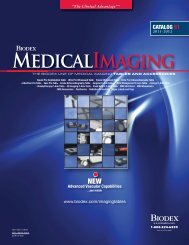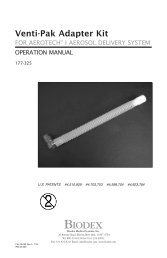Shoulder Dysfunction - Biodex
Shoulder Dysfunction - Biodex
Shoulder Dysfunction - Biodex
You also want an ePaper? Increase the reach of your titles
YUMPU automatically turns print PDFs into web optimized ePapers that Google loves.
FN: 03-028<br />
Evidence-based<br />
Clinical Protocols<br />
1) <strong>Shoulder</strong> <strong>Dysfunction</strong><br />
CLINICAL EDITORS<br />
Morgan Boyle, III, MEd, ATC<br />
Steven Jacoby, ATC<br />
John Guido, PT<br />
EDITOR<br />
Terry McLaughlin, MS, ATC<br />
CONTRIBUTORS<br />
James Andrews, MD<br />
Shad Bernard, ATC<br />
Tab Blackburn, PT, ATC<br />
Marlene DeMaio, MD<br />
Terry Giove, PT<br />
Woody Goffinett, ATC<br />
Steve Hoffman, PT, ATC<br />
Drew Hurley, ATC/L<br />
Ginger Kurmann, PT, ATC<br />
Terry Malone, PT, ATC<br />
Frank Noyes, MD<br />
Clarence Shields Jr., MD<br />
John Stemm, MEd, PT, ATC<br />
Steve Tippett, PT, ATC<br />
Kim VanFleet, MS, ATC/L<br />
Michael Voight, PT, ATC<br />
Kevin Wilk, PT<br />
Gary Wilkerson, Ed.D, ATC
EVIDENCE-BASED CLINICAL<br />
PROTOCOL FOR THE<br />
REHABILITATION OF<br />
SHOULDER DYSFUNCTION<br />
INTRODUCTION........................................................................................................................................................................1-1<br />
REHABILITATION PROGRAM CONSIDERATIONS............................................................................................................1-2<br />
DEFINITIONS...............................................................................................................................................................1-2<br />
PHASE I: Reduction of Acute Symptoms<br />
GOALS (to progress to Phase II) ...................................................................................................................................1-3<br />
CLINICAL EVALUATION................................................................................................................................................1-3<br />
CLINICAL TREATMENT OPTIONS ..................................................................................................................................1-5<br />
SUPERVISED PROGRAM...............................................................................................................................................1-7<br />
HOME PROGRAM .......................................................................................................................................................1-8<br />
REPORTS .....................................................................................................................................................................1-8<br />
PHASE II: Range of Motion and Initial Strengthening<br />
GOALS (to progress to Phase III) ..................................................................................................................................1-9<br />
CLINICAL EVALUATION................................................................................................................................................1-9<br />
CLINICAL TREATMENT OPTIONS ................................................................................................................................1-11<br />
SUPERVISED PROGRAM.............................................................................................................................................1-13<br />
HOME PROGRAM .....................................................................................................................................................1-14<br />
REPORTS ...................................................................................................................................................................1-14<br />
PHASE III: Initial and Intermediate Strengthening<br />
GOALS (to progress to Phase IV)................................................................................................................................1-15<br />
CLINICAL EVALUATION..............................................................................................................................................1-15<br />
CLINICAL TREATMENT OPTIONS ................................................................................................................................1-17<br />
SUPERVISED PROGRAM.............................................................................................................................................1-20<br />
HOME PROGRAM .....................................................................................................................................................1-21<br />
REPORTS ...................................................................................................................................................................1-22<br />
PHASE IV: Return to Activity<br />
GOALS......................................................................................................................................................................1-23<br />
CLINICAL EVALUATION..............................................................................................................................................1-24<br />
CLINICAL TREATMENT OPTIONS ................................................................................................................................1-25<br />
SUPERVISED PROGRAM.............................................................................................................................................1-28<br />
HOME PROGRAM .....................................................................................................................................................1-29<br />
REPORTS ...................................................................................................................................................................1-29<br />
REFERENCES:..........................................................................................................................................................................1-31<br />
© BIODEX MEDICAL SYSTEMS, INC.<br />
table of contents
INTRODUCTION clinical protocol<br />
The Information contained in this manual is presented by <strong>Biodex</strong> Medical Systems as part of our commitment to provide<br />
continuing service to medical professionals and to the community at large.<br />
IMPORTANT: READ BEFORE PROCEEDING<br />
Suggested courses of rehabilitation for any specific conditions are meant as references of generalized program models, and are not<br />
intended as precise prescriptions for individual treatment. The data is a compilation of information based on the work of acknowledged<br />
experts that have been published in respected journals.<br />
We believe it is representative of current trends in scientifically derived and clinically proven principles and methods of rehabilitation<br />
medicine. Much of the published information that we review, however, is based on research and case studies involving very specific<br />
patient or test subject populations. Many research subjects, for instance, are highly-trained and well-conditioned athletes prior to<br />
treatment, or are chosen because they have no known medical problems other than the condition involved in the study. It should<br />
therefore be noted that the application of any published methods should be done with extreme care and should be based on sound<br />
clinical judgment after thorough evaluation of the individual patient's capabilities, limitations, and overall medical condition. In the<br />
presence of any doubt, or question, regarding the efficacy of initiating a procedure, seek advise from appropriate sources and/or<br />
consult with the patient’s physician.<br />
Note: This protocol is intended as a guide for rehabilitation associated with the conservative management of shoulder dysfunction.<br />
Consult the patient’s physician prior to incorporating any of the rehabilitation principles listed below.<br />
Please send any comments or concerns to:<br />
c/o Clinical Education<br />
<strong>Biodex</strong> Medical Systems, Inc.<br />
20 Ramsay Rd.<br />
Shirley, NY 11967-4704<br />
A special thanks goes to Terry McLaughlin, MS, ATC, Steven Jacoby, ATC and Morgan Boyle III, MEd, ATC, for their assistance in the<br />
organization of this protocol.<br />
© BIODEX MEDICAL SYSTEMS, INC. 1-1
REHABILITATION PROGRAM CONSIDERATIONS<br />
The objective of rehabilitation for the conservative management of shoulder dysfunction, is to quickly and efficiently return the<br />
patient to the highest level of pre-injury activity, as is reasonably possible, with minimized risk of increased signs and symptoms,<br />
related complications, or predisposing the patient to re-injury. This program can be used as a preventative measure or as an injury<br />
treatment program.<br />
Prior to the rehabilitation of the patient with shoulder dysfunction, there are five common factors of functional assessment. It is<br />
imperative that the clinician understands the patient's goals and physiologic make-up prior to beginning the rehabilitation process.<br />
The five factors referred to in the literature are:<br />
1. Severity of injury<br />
2. Tissue damage and involvement<br />
3. Tissue status of patient<br />
4. Neuromuscular control<br />
Efficiency of force couples<br />
5. Desired activity level<br />
Overhead activities<br />
Below shoulder activities<br />
DEFINITIONS:<br />
Goals: Specific improvements which must be met in order for patient to progress to next phase.<br />
Clinical Evaluation: Evaluations that are only to be performed by certified and/or licensed PT, OT or ATC, in association with<br />
supervising physician’s diagnosis.<br />
Clinical Treatment Options: Treatment options that should only be performed under the supervision of certified and/or licensed clinicians.<br />
Supervised Program: Rehabilitation program that should be done only under the direction of appropriately qualified personnel<br />
(e.g. Certified Strength and Conditioning Specialist).<br />
Home Program: Rehabilitation program that after proper instruction by supervising clinician, can be done by patient without supervision.<br />
Reports: Test reports are to be completed at the end of each phase to ensure progress to the next phase is indicated.<br />
1-2 INTRODUCTION
GOALS:<br />
• Mentally prepare patient for rehabilitation<br />
PHASE I<br />
• Education of patient to understand the problems of shoulder dysfunction<br />
• Identify specific needs of the patient and potential problems<br />
• Decrease pain and inflammation<br />
• Maintain wrist and elbow Range of Motion (ROM) and strength<br />
• Develop voluntary and involuntary control of shoulder stabilizers<br />
• Correct biomechanical faults<br />
• Identify contributory factors<br />
• Increase shoulder strength and prevent disuse atrophy<br />
• Regain full pain free Passive Range of Motion (PROM) of involved shoulder in all directions<br />
• Proprioception: ER < 40% deficit bilaterally<br />
• Isometric strength: < 50% deficit bilaterally for all directions<br />
CLINICAL EVALUATION:<br />
• General patient history and observation:<br />
To assist in the rehabilitation process, the clinician/physician should complete a thorough subjective evaluation of<br />
mechanism of injury. This will allow the clinician to design strategies to correct the pathology through<br />
operative and/or non-operative means. 4<br />
Muscle atrophy<br />
Scapular winging (scapular slide test) 10<br />
• Visual Pain scale: 15<br />
Location, quality, duration, and intensity<br />
• Edema: degree and character of swelling<br />
• Musculoskeletal evaluation 12<br />
• Range of Motion (ROM):<br />
Involved extremity (PROM)<br />
Uninvolved extremity (AROM / PROM)<br />
• Special Tests:<br />
<strong>Shoulder</strong> instability tests 22<br />
Apprehension:<br />
Apply’s scratch, anterior / posterior drawer, relocation test, etc.<br />
<strong>Shoulder</strong> impingement tests:<br />
Empty can, Hawkins, Neer, Speeds, etc.<br />
Glenoid labral tests:<br />
Clunk, O'Brien, Anterior slide tests 3<br />
reduction of acute symptoms<br />
© BIODEX MEDICAL SYSTEMS, INC. 1-3
CLINICAL EVALUATION (cont):<br />
• Neurological assessment:<br />
Myotomes, Dermatomes and Reflexes for C-3 to T-2<br />
• Scapulohumoral Rhythm:<br />
For each 15° of shoulder abduction, 10° is at the glenohumoral joint and 5° is at the scapulothorasic joint.<br />
TEST: Bilateral Isometric comparison ER/IR modified neutral:<br />
NOTE: Must have non-painful contractions and the decision to test supported by clinical judgment.<br />
Device: <strong>Biodex</strong> Multi-Joint System<br />
Pattern: <strong>Shoulder</strong> ER/IR modified neutral<br />
Report: Bilateral isometric comparison<br />
Setup: Neutral rotation/plane of the scapula<br />
Mode: Isometric<br />
Duration: 5 seconds<br />
Sets and Reps: 1 x 5 reps<br />
Rest between repetitions: 10 seconds<br />
Recommendations: Have the patient perform the test with as maximal tolerable effort as possible. Use pain and<br />
substitution as a guide.<br />
1-4 PHASE I: REDUCTION OF ACUTE SYMPTOMS
CLINICAL TREATMENT OPTIONS:<br />
• Rehabilitation process education:<br />
Clinic familiarization (for patient and family)<br />
Rehabilitation<br />
Psychological preparation<br />
-compliance<br />
-expectations<br />
-precautions<br />
• Reduce spasm, pain and edema:<br />
Protect, Rest, Ice, Compression and Elevation (P.R.I.C.E.)<br />
TENS for pain and spasm control<br />
• Manual Grade I oscillations: 17<br />
To decrease pain and keep the capsule free from adhesions.<br />
• Range of Motion (ROM) exercises:<br />
Following acute injury, the initial program should be to restore motion to the shoulder as pain free as possible. 8<br />
Pendulum swings (non weighted) 9<br />
Sets and Reps: 2 x 25<br />
Recommendations: Perform one set of clockwise and counterclockwise (CW/CCW), flexion and extension (FLEX/EXT),<br />
and horizontal abduction and adduction (Horiz ABD/ADD). Ensure that the shoulder is relaxed during rotations.<br />
Wall walking<br />
Pattern: Abduction and Flexion (ABD + FLEX)<br />
Sets and Reps: 2 x 15 each pattern<br />
Recommendations: Use pain as a guide. If impingement exists, stay below shoulder height.<br />
Active assist T-bar exercises (FLEX and IR in neutral or plane of the scapula)<br />
Sets and Reps: 2 x 15<br />
Recommendation: Use pain as a guide. The use of a transfer belt is recommended around the chest and scapula to<br />
prevent scapular winging.<br />
Device: <strong>Biodex</strong> Multi-Joint System<br />
Pattern: shoulder IR/ER and shoulder FLEX/EXT<br />
Setup: <strong>Shoulder</strong> abduction to 40º flexion to 30º; elbow flexion 90º 8<br />
Mode: Passive<br />
Duration: 15-20 min as tolerated<br />
Speed: Begin at 10 deg/sec and progress as tolerated<br />
Recommendations: Instruct patient to produce no force. Begin with ROM percent dials at 50% for IR/ER. Determine pain<br />
free ROM by the gradual adjustment of dials.<br />
• Posture control:<br />
Generally recommended, but has not demonstrated any correlation to shoulder injury 14<br />
Gentle shoulder shrugs (caution on the eccentric phase)<br />
Scapular retraction<br />
© BIODEX MEDICAL SYSTEMS, INC. 1-5
CLINICAL TREATMENT OPTIONS (cont):<br />
• Open Kinetic Chain (OKC) Proprioception:<br />
Device: <strong>Biodex</strong> Multi-Joint System<br />
Passive, Active and Threshold to detect passive movement*<br />
Pattern: ER/IR modified neutral<br />
Mode: Passive and Isokinetic<br />
Sets and Reps: 3 x 5 each target angle<br />
Target Angle: ROM dependent (see recommendations)<br />
Recommendations: Be cautious with the target angle selected. There should be NO incidence of pain or inhibition.<br />
*NOTE: Threshold to detect passive movement for System 2 users with 4.5 or 4.6 software<br />
Manual Proprioceptive Neuromuscular Facilitation (PNF) Patterns<br />
Pattern: D1 and D2*<br />
Sets and Reps: 2 x 10 each pattern (progress to 3 sets of 12 reps)<br />
Recommendations: Each pattern should be done within the comfort level of the patient, within the pain-free range<br />
of motion.<br />
*NOTE: Each pattern should be indicated by clinical findings. Not every pathology allows for the<br />
pain-free movement of each pattern.<br />
Device: <strong>Biodex</strong> Closed Chain Attachment<br />
Pattern: Scapular retractors 24<br />
Setup: Begin with shoulder flexion at 70° and progress to 90° when there are no signs of impingement<br />
Mode: Passive<br />
Sets and Reps: 2 x 15<br />
Speed: 10 deg/sec<br />
Recommendations: Have the patient perform sub-maximal retraction eccentrics. Utilize the torque limits to limit maximal<br />
torque at 10ft/lb. A belt can be used around the chest to limit excessive trunk motion.<br />
Device: Cable Column<br />
Pattern: elbow FLEX/EXT with arm at side<br />
Setup: unilateral single hand grip at bottom of cable column<br />
Sets and Reps: 3 x 8-10<br />
Weight: Begin with 1 plate and progress at tolerated<br />
Scapulothoracic neuromuscular control exercises 35<br />
Side-lying scapular retraction, elevation, and depression<br />
Sets and Reps: 3 x 10-12<br />
Recommendations: Increase the amount of repetitions as needed<br />
• Cardiovascular training:<br />
Device: <strong>Biodex</strong> Upper Body Cycle<br />
Setup: Actuator tilt so the shoulder is flexed below 90º (no pain)<br />
Duration: Begin with 3 min and progress to 5 min by end of phase<br />
Speed: 120 deg/sec<br />
Recommendations: Ensure that glenohumeral motion is limited below 90º of shoulder flexion<br />
Device: <strong>Biodex</strong> BioStep ® Semi-Recumbent Elliptical<br />
Setup: Seat height adjusted so knee is at 10º in full extension<br />
Duration: Begin with 10 min and progress to 15 min end of the phase<br />
Speed: 90-120 deg/sec<br />
Device: <strong>Biodex</strong> Rehabilitation Treadmill<br />
Setup: 0% incline<br />
Duration: Begin with 5-10 min and progress as tolerated<br />
Speed: Begin walking (3mph) and progress as tolerated<br />
Recommendations: Monitor levels of intensity and progress as tolerated<br />
*NOTE: Swinging the arms during ambulation has been shown to increase the firing of the rotator cuff musculature.<br />
1-6 PHASE I: REDUCTION OF ACUTE SYMPTOMS
SUPERVISED PROGRAM:<br />
• Control edema and manage pain:<br />
P.R.I.C.E.<br />
• Strengthening:<br />
<strong>Shoulder</strong> FLEX/EXT, ER/IR and ABD/ADD Isometrics<br />
Sets and Reps: 1 x 10<br />
Contraction duration: 6 seconds<br />
Recommendation: Utilize doorway to perform exercises. All exercises should be performed in the scapular plane.<br />
Elbow flexion and extension (isotonics)<br />
Sets and Reps: 3 x 15<br />
Weight: Begin with 1-2 plates and progress as tolerated<br />
Wrist FLEX/EXT and Supination/Pronation<br />
Sets and Reps: 3 x 15<br />
Weight: Begin with 1-2 pounds and progress as tolerated<br />
• Scapular exercises:<br />
Shrugs, retraction, scaption, shoulder rows, and prone extension<br />
Sets and Reps: 3 x 15<br />
Weight: Begin with weight used at end of last phase<br />
• <strong>Shoulder</strong> isotonics:<br />
ABD/ADD in scapular plane, bench press motion in scapular plane, reverse rows<br />
Sets and Reps: 3 x 15<br />
Weight: Begin with no weight and progress as tolerated<br />
• Proprioception:<br />
Quadraped closed chain<br />
Sets: 1-2<br />
Duration: 30 seconds<br />
Recommendations: Have patient axially load the Glenohumeral joint to increase stability and proprioceptive abilities.<br />
• Flexibility training: 28<br />
<strong>Shoulder</strong> bar (FLEX to 80°, ER in modified neutral to 45°, IR)<br />
Sets and Reps: 1 x 5-6<br />
Duration of hold: 20 seconds<br />
• Cardiovascular training:<br />
Device: <strong>Biodex</strong> Upper Body Cycle (only if patient can cycle below 90° of shoulder flexion)<br />
Duration: Begin at 3 min and progress to 15 min<br />
Speed: 120 deg/sec<br />
Recommendations: Ensure that shoulder is below 90° of shoulder flexion<br />
Device: BioStep ® Semi-Recumbent Elliptical<br />
Duration: Start with 10 min and progress to 15 min<br />
Speed: 90-120 deg/sec<br />
© BIODEX MEDICAL SYSTEMS, INC. 1-7
HOME PROGRAM:<br />
• Control pain and swelling:<br />
(P.R.I.C.E.)<br />
• Range of Motion (ROM) exercises:<br />
<strong>Shoulder</strong> T-bar<br />
<strong>Shoulder</strong> flexion to 90°<br />
ER/IR in at modified neutral<br />
Sets and Reps: 1 x 15<br />
Duration of hold: 5 seconds<br />
Pendulum swings<br />
<strong>Shoulder</strong> FLEX/EXT horizontal ABD/ADD, and CW/CCW<br />
Weight: Begin with no weight and progress as tolerated<br />
Sets and Reps: 2 x 25 each direction<br />
Times daily: 4-5<br />
Recommendations: The exercise should be performed in a relaxed state. Do not have the patient "actively" swing the arm.<br />
• Strengthening:<br />
<strong>Shoulder</strong> ER/IR isometrics<br />
Setup: Standing with towel roll under axilla<br />
Sets and Reps: 2 x 15<br />
Contraction duration: 2 seconds<br />
Recommendation: Utilize doorway to perform exercises. Exercises should be performed in the scapular plane. Use pain<br />
as a guide for effort.<br />
<strong>Shoulder</strong> FLEX/EXT and ABD/ADD Isometrics<br />
Setup: Standing<br />
Sets and Reps: 2 x 15<br />
Contraction duration: 2 seconds<br />
Recommendation: Utilize doorway to perform exercises. Exercises should be performed in straight plane. Use pain as a<br />
guide for effort.<br />
Elbow FLEX/EXT Isotonics<br />
Sets and Reps: 3 x 15<br />
Weight: Begin with 2 pound and progress as tolerated<br />
Wrist FLEX/EXT and Pron/Sup Isotonics<br />
Sets and Reps: 3 x 15<br />
Weight: Begin with 2 pounds and progress as tolerated<br />
• Cardiovascular training:<br />
Device: <strong>Biodex</strong> Rehabilitation Treadmill<br />
Intensity: 65-80% MHR for 20 mins. 3-4 times a week<br />
REPORTS:<br />
• Passive and Active Range of Motion:<br />
FLEX/EXT, ER/IR and ABD/ADD<br />
• Pain scale<br />
• Level of cardiovascular fitness:<br />
Establish: distance traveled, speed attained and duration of exercise<br />
• <strong>Biodex</strong> bilateral proprioception for ER/IR in modified neutral<br />
• <strong>Biodex</strong> bilateral isometric comparison for FLEX/EXT, ER/IR modified neutral and ABD/ADD<br />
1-8 PHASE I: REDUCTION OF ACUTE SYMPTOMS
GOALS:<br />
• Full pain free PROM and AROM<br />
• Decrease pain and inflammation<br />
• Maintain wrist and elbow ROM and strength<br />
• Continue to develop voluntary and involuntary control of shoulder stabilizers<br />
• Increase cardiovascular conditioning<br />
• Increase functional activity levels<br />
• Proprioception: ER/IR modified neutral < 30% deficit bilaterally<br />
• Isometric strength: < 30% deficit bilaterally for all directions<br />
• Isokinetic strength: ER/IR modified neutral < 50% deficit bilaterally<br />
CLINICAL EVALUATION:<br />
• Verify home compliance<br />
• General observation:<br />
Muscle atrophy<br />
Scapular winging (scapular slide test)<br />
• Pain: Location; quality, duration, radiation, and severity<br />
Evaluate pain throughout the ROM and note at end ranges of motion<br />
• Range of Motion:<br />
Involved extremity (AROM / PROM)<br />
Uninvolved extremity (AROM / PROM)<br />
• Neurological assessment:<br />
Myotomes, Dermatomes and Reflexes for C-3 to T-2<br />
PHASE II range of motion & initial strengthening<br />
TEST: Bilateral Isometric comparison external/internal rotation (ER/IR) modified neutral:<br />
NOTE: Must have non-painful contractions and the decision to test supported by clinical judgment.<br />
Device: <strong>Biodex</strong> Multi-Joint System<br />
Pattern: <strong>Shoulder</strong> ER/IR modified neutral<br />
Report: Bilateral isometric comparison<br />
Setup: Neutral rotation/plane of the scapula<br />
Mode: Isometric<br />
Duration: 5 seconds<br />
Sets and Reps: 1 x 5 reps<br />
Rest between repetitions: 10 seconds<br />
Recommendations: Have the patient perform the test with as maximal tolerable effort as possible. Use pain and<br />
substitution as a guide.<br />
© BIODEX MEDICAL SYSTEMS, INC. 1-9
CLINICAL EVALUATION (cont):<br />
• Neurological assessment (cont):<br />
TEST: Bilateral Isokinetic comparison external/internal rotation (ER/IR) modified neutral:<br />
Note: Must have pain-free contractions and the decision to test supported by clinical judgment.<br />
Device: <strong>Biodex</strong> Multi-Joint System<br />
Pattern: <strong>Shoulder</strong> ER/IR modified neutral<br />
Report: Bilateral isokinetic comparison<br />
Setup: Neutral rotation/plane of the scapula<br />
Mode: Isokinetic 29<br />
Reps and Speeds: 5 @ 180 deg/sec<br />
10 @ 300 deg/sec<br />
Recommendations: General weakness is to be noted at this time. Point out a parameter on the report that highlights<br />
positives, not negatives. This test is performed at the end of the phase.<br />
TEST: Bilateral proprioceptive comparison: 7<br />
Device: <strong>Biodex</strong> Multi-Joint System<br />
Pattern: <strong>Shoulder</strong> ER/IR *(as close to the 90°/ 90° position as possible)<br />
Motion: Active (muscle spindle) and Passive (joint capsule, ligament, labral, mechanoreceptor)<br />
Starting angle: Neutral rotation/plane of the scapula<br />
Target angle: 15° less than maximum ER ROM<br />
Speed: 2 deg/sec<br />
Trials: Average of three<br />
Target angle-pretest hold: 10 seconds<br />
*NOTE: Have the patient perform the movement at a position where the capsule is at its most lengthened position.<br />
1-10 PHASE II: RANGE OF MOTION & INITIAL STRENGTHENING
CLINICAL TREATMENT OPTIONS:<br />
• Reduce edema/inflammation:<br />
P.R.I.C.E.<br />
• Range of Motion (ROM) exercises:<br />
Active-assisted <strong>Shoulder</strong> Flex to 90º<br />
Passive ER *<br />
Active-assisted IR *<br />
Active-assisted Abduction *<br />
Sets and Reps: 1x 5-6 each<br />
Duration: 20 seconds<br />
Recommendation: Perform exercises in the scapular plane<br />
* without positive impingement sign<br />
• Postural control:<br />
<strong>Shoulder</strong> shrugs<br />
Scapular retraction<br />
Sets and Reps: 3 x 10<br />
Recommendations: Caution must be noted on the eccentric phase of the shrug<br />
NOTE: Taping of the scapula has been shown to assist the clinician with assisting in scapular control. Have patient<br />
perform these exercises in neutral spine.<br />
• Strengthening exercises:<br />
Device: <strong>Biodex</strong> Multi-Joint System<br />
Pattern: <strong>Shoulder</strong> FLEX/EXT, ABD/ADD and ER/IR in modified neutral<br />
Mode: Isometric (Progress to Passive)<br />
Duration: 5 sec each<br />
Speed: Begin with multiple angle Isometric contractions. Initiate movement at 30 deg/sec and progress at tolerated<br />
Sets and Reps: 1 x 10 (progress to 3 sets)<br />
Recommendations: Have patient produce sub-maximal effort and gradually increase effort. Use clinical judgment to<br />
determine effort level. Biofeedback may be used to train the patient to fire the infraspinatus first with exercises that cause<br />
increased GH translation. 26<br />
With passive movement, ER should be limited to ensure no increased GH motion.<br />
Device: <strong>Biodex</strong> Multi-Joint System<br />
Pattern: <strong>Shoulder</strong> ER/IR in scapular plane<br />
Mode: Passive (Progress to Isokinetic)<br />
Speeds: 45-60 deg/sec<br />
Sets and Reps: 3 x 10<br />
Recommendations: Begin active assistive ER/IR in the passive mode. Once the patient performs active assistive<br />
contractions in the passive mode, without increased complaints of pain or apprehension,<br />
sub-maximal eccentric contractions could be initiated in passive mode. Progress to concentric /concentric isokinetic<br />
contractions as supported by clinical findings.<br />
• Manual resistance exercises:<br />
<strong>Shoulder</strong> proprioceptive neuromuscular facilitation (PNF) patterns D1/D2<br />
Sets and Reps: 3 x 10-12<br />
Recommendations: Ensure that there is no increased pain with diagonals over 90º of shoulder FLEX/EXT<br />
<strong>Shoulder</strong> Stabilization<br />
Sets and Reps: 3 x 10-12<br />
Recommendations: Apply force to distal arm in multiple planes with patient maintaining a constant shoulder position.<br />
Have patient resist at multiple angles of horizontal ABD/ADD.<br />
Side-lying scapular retraction/protraction, elevation/depression<br />
Sets and Reps: 3 x 10-12<br />
Recommendations: Increase repetitions as needed<br />
© BIODEX MEDICAL SYSTEMS, INC. 1-11
CLINICAL TREATMENT OPTIONS (cont):<br />
• Closed Kinetic Chain (CKC) exercises: 30<br />
Wall push-ups (Progress to push-ups with a plus)<br />
Sets and Reps: 3 x 10-12<br />
Recommendations: Arm height below 90º of shoulder flexion. No pain or scapular winging<br />
should be present.<br />
Device: <strong>Biodex</strong> Closed Chain Attachment 30<br />
Pattern: <strong>Shoulder</strong> protraction/retraction and horizontal ABD/ADD<br />
Mode: Passive<br />
Speeds: 5 deg/sec<br />
Sets and Reps: 2 x 15-20<br />
• Recommendations<br />
<strong>Shoulder</strong> flexion less than 90º. There should be no pain and scapular winging. When performing the horizontal<br />
ABD/ADD, start with a very limited ROM and progress as tolerated. This exercise requires a great amount of<br />
lumbar stabilization, be cautious with patients with lumbar pathologies. This is a rhythmic<br />
stabilization technique.<br />
• Open Kinetic Chain (OKC) Proprioception:<br />
Device: <strong>Biodex</strong> Multi-Joint System<br />
Passive, Active and Threshold to detect passive movement*<br />
Pattern: ER/IR modified neutral<br />
Mode: Passive and Isokinetic<br />
Sets and Reps: 1 x 10-12 each mode<br />
Target Angle: 15º less than maximal ER<br />
Passive speed: 2 deg/sec<br />
Active speed: 180 deg/sec<br />
Target angle hold: 10 sec<br />
Recommendations: Be cautious with the target angle selected. There should be no incidence of pain or inhibition.<br />
*NOTE: Threshold to detect passive movement for System 2 users with 4.5 or 4.6 software<br />
• Cardiovascular training:<br />
Device: <strong>Biodex</strong> Upper Body Cycle (only if patient can cycle below 90° of shoulder flexion)<br />
Duration: Begin at 5 min and progress to 7 min<br />
Speed: 120 deg/sec<br />
Recommendations: Ensure that shoulder is below 90° of shoulder flexion.<br />
Device: <strong>Biodex</strong> BioStep ® Semi-Recumbent Elliptical<br />
Duration: Start with 15 min and progress to 20 min<br />
Device: <strong>Biodex</strong> Rehabilitation Treadmill<br />
Setup: 0% incline<br />
Duration: Begin with 5-10 min and progress as tolerated<br />
Speed: Begin walking (3mph) and progress as tolerated<br />
Recommendations: Monitor levels of intensity and progress as tolerated. Swinging the arms during ambulation has been<br />
shown to increase the firing of the rotator cuff musculature.<br />
1-12 PHASE II: RANGE OF MOTION & INITIAL STRENGTHENING
SUPERVISED PROGRAM:<br />
• Range of Motion (ROM) / flexibility exercises:*<br />
Pendulum swings<br />
Weight: Begin with no weight and progress as tolerated<br />
Sets and Reps: 2 x 25 clockwise and 25 counterclockwise<br />
<strong>Shoulder</strong> T-bar<br />
Sets and Reps: 1 x 5-6<br />
Duration of hold: 20 seconds<br />
* Should have full ROM at end of phase<br />
• Strengthening:<br />
<strong>Shoulder</strong> FLEX/EXT, ER/IR isometrics<br />
Sets and Reps: 1 x 10<br />
Contraction duration: 8 seconds<br />
Recommendation: Utilize doorway to perform exercises. All exercises should be performed in the scapular plane.<br />
Device: Cable Column<br />
Elbow FLEX/EXT Isotonics<br />
Sets and Reps: 3 x 15<br />
Weight: Begin with weight at end of Phase I and progress as tolerated<br />
Wrist FLEX/EXT, SUP/PRON Isotonics<br />
Sets and Reps: 3 x 15<br />
Weight: Begin with weight at end of Phase I and progress as tolerated<br />
<strong>Shoulder</strong> shrugs, retraction, shoulder row and prone extension<br />
Sets and Reps: 3 x 15<br />
Weight: Begin with weight at end of Phase I and progress as tolerated<br />
<strong>Shoulder</strong> ABD/ADD in scapular plane, bench press motion in scapular plane and reverse rows<br />
Sets and Reps: 3 x 15<br />
Weight: Begin with no weight and progress as tolerated<br />
• Advanced scapular exercises:<br />
Seated press-ups, prone horizontal shoulder abduction, prone external rotation, prone extension,<br />
abduction in scapular plane<br />
Sets and Reps: 3 x 15<br />
Weight: Begin with weight at end of Phase I<br />
• Proprioception:<br />
Quadruped closed chain<br />
Sets and Duration: 1-2 x 30 seconds<br />
Recommendations: Have patient axially load the GH joint to increase joint stability and proprioceptive abilities.<br />
• Cardiovascular Training:<br />
65-80% MHR for > 20 min<br />
© BIODEX MEDICAL SYSTEMS, INC. 1-13
HOME PROGRAM:<br />
• Control pain and swelling:<br />
P.R.I.C.E.<br />
• Range of Motion (ROM) exercises:<br />
Pendulum swings<br />
Weight: Begin with no weight and progress as tolerated<br />
Sets and Reps: 2 x 25 clockwise and 25 counterclockwise<br />
<strong>Shoulder</strong> bar<br />
<strong>Shoulder</strong> flexion to 90°, ER (neutral) to 45°<br />
Sets and Reps: 1 x 5-6<br />
Duration of hold: 20 seconds<br />
• Strengthening:<br />
<strong>Shoulder</strong> 4-way isometrics:<br />
FLEX/EXT, IR/ER, ABD/ADD with arm in scapular plane<br />
Sets and Reps: 2 x 15<br />
Contraction duration: 2 seconds<br />
Recommendation: Utilize doorway to perform exercises. All exercises should be performed in modified neutral.<br />
Elbow FLEX/EXT (isotonics)<br />
Sets and Reps: 3 x 15<br />
Weight: Begin with last plate of Phase I and progress as tolerated<br />
Wrist FLEX/EXT, SUP/PRON Isotonics<br />
Sets and Reps: 3 x 15<br />
Weight: Begin with last weight used in Phase I and progress as tolerated<br />
Wall push-ups progress to pushups with a plus by the end of the Phase 23<br />
Arm height below 90° of shoulder flexion<br />
No pain and/or scapular winging should be present<br />
IR/ER, seated rows, protraction/retraction, shoulder extension, shrugs and scaption latex tubing exercises:<br />
Sets and Reps: 3 x 15<br />
Recommendations: Begin with moderate tubing a progress as tolerated<br />
• Proprioception<br />
Closed chain quadruped and tripod stabilization techniques<br />
• Cardiovascular training<br />
20-30 min of moderate activity 3-4 times per week<br />
REPORTS:<br />
• Passive and Active Range of Motion:<br />
FLEX/EXT, ER/IR and ABD/ADD<br />
• Pain scale<br />
• Level of cardiovascular fitness:<br />
Establish: distance traveled, speed attained and duration of exercise<br />
• <strong>Biodex</strong> bilateral proprioception for ER/IR at 90º/90º<br />
• <strong>Biodex</strong> bilateral isometric comparison for FLEX/EXT, ER/IR modified neutral and ABD/ADD<br />
• <strong>Biodex</strong> bilateral isokinetic comparison for ER/IR in modified neutral<br />
1-14 PHASE II: RANGE OF MOTION & INITIAL STRENGTHENING
GOALS:<br />
• Full pain free PROM and AROM<br />
• No pain or inflammation<br />
• No complaints of palpable tenderness<br />
• Increase wrist and elbow ROM and strength<br />
• Continue to develop voluntary and involuntary control of shoulder stabilizers<br />
• Increase cardiovascular conditioning<br />
• Increase functional activity levels with no complaints of pain<br />
• Proprioception: ER/IR 90/90 < 20% deficit bilaterally<br />
• Isometric strength: < 10% deficit bilaterally for all directions<br />
• Isokinetic strength: ER/IR @ modified neutral < 20% deficit bilaterally<br />
CLINICAL EVALUATION:<br />
• Verify home program compliance<br />
• General observation:<br />
Muscle Hypertrophy<br />
Scapular winging (scapular slide test)<br />
• Pain: Location; quality, duration, radiation, and severity:<br />
Evaluate pain throughout the ROM and note at end ranges of motion<br />
• Range of Motion (ROM):<br />
Involved extremity (AROM / PROM)<br />
Uninvolved extremity (AROM / PROM)<br />
* Should have full ROM<br />
• Neurological assessment:<br />
Myotomes, Dermatomes and Reflexes for C-3 to T-2<br />
PHASE III initial and intermediate strengthening<br />
TEST: Bilateral Isometric comparison ER/IR 90/90:<br />
NOTE: Must have non-painful contractions and the decision to test supported by clinical judgment.<br />
Device: <strong>Biodex</strong> Multi-Joint System<br />
Pattern: <strong>Shoulder</strong> external/internal rotation (ER/IR) modified neutral<br />
Report: Bilateral isometric comparison<br />
Setup: Neutral rotation/plane of the scapula<br />
Mode: Isometric<br />
Duration: 5 seconds<br />
Sets and Reps: 1 x 5 reps<br />
Rest between repetitions: 10 seconds<br />
Recommendations: Have the patient perform the test with as maximal tolerable effort as possible. Use pain and<br />
substitution as a guide.<br />
© BIODEX MEDICAL SYSTEMS, INC. 1-15
CLINICAL EVALUATION (cont):<br />
• Neurological assessment (cont):<br />
TEST: Bilateral Isokinetic comparison external/internal rotation (ER/IR) @ modified neutral:<br />
Note: Must have non-painful contractions and the decision to test supported by clinical judgment.<br />
Device: <strong>Biodex</strong> Multi-Joint System<br />
Pattern: <strong>Shoulder</strong> ER/IR modified neutral<br />
Report: Bilateral isokinetic comparison<br />
Setup: Neutral rotation/plane of the scapula<br />
Mode: Isokinetic 29<br />
Reps and Speeds: 5 @ 180 deg/sec , 10 @ 300 deg/sec<br />
Recommendations: General weakness is to be noted at this time. Point out a parameter on the report that highlights<br />
positives, not negatives. This test is performed at the end of the phase.<br />
TEST: Bilateral proprioceptive comparison: 7<br />
Device: <strong>Biodex</strong> Multi-Joint System<br />
Pattern: <strong>Shoulder</strong> ER/IR *(as close to the 90° / 90° position as possible)<br />
Motion: Active and Passive<br />
Starting angle: Neutral rotation/plane of the scapula<br />
Target angle: 75° of ER by apprehension tests<br />
Speed: 2 deg/sec<br />
Trials: Average of three<br />
Target angle-pretest hold: 10 seconds<br />
*NOTE: Have the patient perform the movement at a position where the capsule is at its most lengthened position.<br />
TEST: Plyoback ® test<br />
A sample test that can be used to determine accuracy and frequency of a upper extremity plyometric movement.<br />
Position: IR/ER 90º/90º<br />
Distance from Plyoback ® : 2x arm length<br />
Weight of ball: 4 pounds<br />
Target dimension: Twice the size of the ball<br />
Time: 1 minute<br />
Testing procedures: Have the patient assume the above position. With the ball in hand, have a technician ready to note<br />
time and reps. The patient will toss the plyometric ball into the circle as many times as possible. At the end of the<br />
minute, the number of repetitions in the circle will be counted. Use this number as a guideline for Phase IV.<br />
1-16 PHASE III: INITIAL AND INTERMEDIATE STRENGTHENING
CLINICAL TREATMENT OPTIONS:<br />
• Control pain and swelling:<br />
P.R.I.C.E.<br />
• Range of Motion (ROM) exercises:<br />
Towel Stretching<br />
Sets and Reps: 2 x 5-6<br />
Duration: 20-30 seconds<br />
Recommendations: Have the patient perform self-stretching techniques for ER/IR. A towel can be used to assist with<br />
the motion.<br />
• Strengthening exercises:<br />
Device: <strong>Biodex</strong> Multi-Joint System<br />
Pattern: <strong>Shoulder</strong> FLEX/EXT, ABD/ADD, ER/IR @ modified neutral and protraction/retraction<br />
Mode: Isokinetic<br />
Speed: 180-300 deg/sec<br />
Sets and Repetitions: 1 x 10-12<br />
Recommendations: Ensure that the patient has no increased complaints of pain or instability with the ER and abduction<br />
portion of the movement.<br />
Device: Cable Column<br />
Pattern: <strong>Shoulder</strong> FLEX/EXT, ABD/ADD and ER/IR @ modified neutral<br />
Sets and Reps: 2 x 15 (progress to 3 x 20)<br />
Weights: begin with 2 pounds and progress from there<br />
Recommendations: It has been noted that working the external rotators eccentrically, increases both concentric and<br />
eccentric strength characteristics. By doing concentric exercise only, there is no change in eccentric strength. 13<br />
<strong>Shoulder</strong> isotonics*: 24<br />
Serratus Anterior<br />
Push-up with a plus<br />
Punching motion<br />
Middle Trapezius/Rhomboids<br />
Seated Rows<br />
Upper Trapezius/Levator Scapula<br />
<strong>Shoulder</strong> shrugs with tubing<br />
Prone shoulder horizontal abduction<br />
Lower Trapezius/Pectoralis Major<br />
Seated press-ups<br />
External rotators<br />
Prone ER<br />
Abduction in plane of scapula<br />
*NOTE: All exercises should begin with weight, or tubing, that was used at the end of Phase II. Progress resistance, sets<br />
and reps as tolerated.<br />
• Strengthening exercises:<br />
Device: <strong>Biodex</strong> Multi-Joint System<br />
Pattern: Concentric/Eccentric shoulder ER ONLY (scapular plane)<br />
Mode: Passive<br />
Speeds: 60-120 deg/sec<br />
Sets and Reps: 2 x 8-10 (progress to 3 sets)<br />
Recommendations: Have the patient initiate a concentric ER muscle contraction. When the shoulder attachment begins<br />
to move into IR, have the patient resist the movement. Begin to increase abduction as tolerated.<br />
© BIODEX MEDICAL SYSTEMS, INC. 1-17
CLINICAL TREATMENT OPTIONS (cont):<br />
• Open Kinetic Chain (OKC) Proprioception:<br />
Device: <strong>Biodex</strong> Multi-Joint System<br />
Passive, Active and Threshold to detect passive movement*<br />
Pattern: ER/IR 90/90<br />
Mode: Passive and Isokinetic<br />
Sets and Reps: 1 x 10-12 each mode<br />
Target Angle: 15º less than maximal ER<br />
Passive speed: 2 deg/sec<br />
Active speed: 180 deg/sec<br />
Target angle hold: 10 sec<br />
Recommendations: Be cautious with the target angle selected. There should be NO incidence of pain or inhibition.<br />
*NOTE: Threshold to detect passive movement for System 2 users with 4.5 or 4.6 software<br />
• Closed Kinetic Chain (CKC) Proprioception:<br />
Push ups and push ups with a plus 25<br />
Positioning: May begin with different levels of hand placement<br />
Sets and Reps: 2 x 10-12<br />
Recommendations: For increased difficulty, have the patient begin with hands on a 3" high raised surface on either side.<br />
Instruct patient to lower chest to below hand height before beginning the press upward off the blocks.<br />
Floor stabilization exercises:<br />
Sets and Duration: 2 x 20 seconds (progress to 40 seconds by end of phase)<br />
Recommendations: Have the patient assume a push-up position. Begin with feet on floor and progress to an unstable<br />
surface (ball /wobble board)<br />
Device: <strong>Biodex</strong> Stability System<br />
Begin with a stable platform and progress as tolerated to an unstable platform<br />
Sets and Duration: 1-2 x 20 seconds (progress as tolerated)<br />
Recommendations: CAUTION must be noted about the platform<br />
• Closed Kinetic Chain Exercises<br />
Device: <strong>Biodex</strong> Multi-Joint System<br />
Attachment: Closed Chain Attachment<br />
Pattern: <strong>Shoulder</strong> protraction/retraction and horizontal ABD/ADD<br />
Mode: Passive<br />
Speeds: 5 deg/sec<br />
Sets and Duration: 1 x 3 min (progress to 5 by end of phase)<br />
Recommendations: Have no shoulder flexion greater than 90º. There should be no pain or scapular winging noted.<br />
• Cardiovascular training<br />
Device: <strong>Biodex</strong> Upper Body Cycle<br />
Direction: forward and reverse<br />
Duration: Begin at 7 min and progress as needed<br />
Speed: 120 deg/second<br />
Recommendations: Ensure that shoulder is below 90° of shoulder flexion<br />
Device: <strong>Biodex</strong> BioStep ® Semi-Recumbent Elliptical<br />
Duration: As needed<br />
Speed: Vary speeds as needed<br />
Device: Rehabilitation Treadmill<br />
Setup: 0% incline<br />
Duration: Begin with 5-10 min and progress as tolerated<br />
Speed: Begin at speed used at end of the last phase<br />
Recommendations: Monitor levels of intensity and progress as tolerated<br />
1-18 PHASE III: INITIAL AND INTERMEDIATE STRENGTHENING
CLINICAL TREATMENT OPTIONS (cont):<br />
• Plyometrics (Stretch-Shortening exercise drills): 32<br />
Underhand throws<br />
Sets and Reps: 2 x 10<br />
Setup: Rebound device with a 3-4 pound weight<br />
Chest throws<br />
Sets and Reps: 2 x 10<br />
Setup: Rebound device with a 3-4 pound weight<br />
2 hand side-to-side throws<br />
Sets and Reps: 2 x 10<br />
Setup: Rebound device with a 3-4 pound weight<br />
Assisted wall push-ups<br />
Sets and Reps: 2 x 10<br />
Recommendations: Have the clinician stand behind the patient and instruct them to press out having the hands lift<br />
"slightly" of the wall and then back on.<br />
• Plyometrics (Stretch-Shortening exercise drills):<br />
ER/IR plyometrics with exercise tubing<br />
Position: Neutral (progress to 90º/90º)<br />
Sets and Reps: 2 x 10<br />
Resistance: Light tubing (progress to heavier)<br />
D1/D2 plyometrics with exercise tubing<br />
Sets and Reps: 2 x 10<br />
Resistance: Light tubing (progress to heavier)<br />
Recommendation: Begin with extension only and progress to full ROM)<br />
NOTE: It is recommended that prior to beginning any plyometric training session, adequate warm-up exercises should<br />
be performed.<br />
• Manual Resistance exercises:<br />
<strong>Shoulder</strong> PNF patterns D1/D2<br />
Sets and Reps: 3 x 10-12<br />
Recommendations: Ensure that there is no increased pain with diagonals over 90º of shoulder FLEX/EXT<br />
Scapular neuromuscular control (elevation/depression and protraction/retraction) 32<br />
Sets and Reps: 2 x 10<br />
Recommendations: Progress from straight movements to circular and diagonal patterns<br />
© BIODEX MEDICAL SYSTEMS, INC. 1-19
SUPERVISED PROGRAM<br />
• Control edema and manage pain:<br />
(P.R.I.C.E.)<br />
• Isotonic strengthening:<br />
<strong>Shoulder</strong> flexion, extension, abduction, adduction, IR and ER<br />
Sets and Reps: 2 x 15-20 (progress to 3 sets)<br />
Weights: Begin with weight at end of Phase II and progress as tolerated<br />
Recommendations: When doing abduction and flexion exercises, ensure that there is no scapular winging involved.<br />
Primary movers: Military press, lateral raises, chest press<br />
Sets and Reps: 2 x 8-10 (progress to 3 sets)<br />
Weight: Begin with weight at end of Phase II and progress as tolerated<br />
Recommendations: Be cautious when establishing abducted and externally rotated exercises<br />
Scapular exercises: <strong>Shoulder</strong> shrugs, retraction, seated rows and prone extension<br />
Sets and Reps: 3 x 25<br />
Weight: Begin with weight at end of Phase II and progress as tolerated<br />
Seated/lying advanced scapular exercises: Seated press-up, prone horizontal shoulder, prone external rotation<br />
(asymtotic), prone extension, abduction (in the plane of the scapula)<br />
Sets and Reps:3 x 15<br />
Weight: Begin with no weight and progress as tolerated<br />
• Stretching exercises: Post exercise PRN<br />
Towel stretch (IR)<br />
Hitchhiker stretch (ER)<br />
• Cardiovascular training<br />
Device: <strong>Biodex</strong> Upper Body Cycle<br />
Duration: As tolerated<br />
Speed: 120 deg/sec<br />
Recommendations: Have the patient work in various ROM's to ensure the musculature is being worked at various angles<br />
Device: <strong>Biodex</strong> BioStep ® Semi-Recumbent Elliptical<br />
Duration: As tolerated<br />
Speed: 90-120 deg/sec<br />
Recommendations: Utilize various training principles for CV exercise<br />
Device: <strong>Biodex</strong> Rehabilitation Treadmill<br />
Setup: 0% incline<br />
Duration: 15-20 min and progress as tolerated<br />
Speed: Begin walking (4-5mph) and progress as tolerated<br />
Recommendations: Monitor levels of intensity and progress as tolerated. Swinging the arms during ambulation has been<br />
shown to increase the firing of the rotator cuff musculature.<br />
• Proprioception:<br />
Quadruped and Tripod stabilization<br />
• Plyometrics:<br />
Wall push-ups<br />
Sets and Reps: 2 x 10-12<br />
Recommendations:. Have the exercise specialist stand behind the patient and instruct them to press out having the<br />
hands lift "slightly" off the wall and then back on.<br />
Under hand throw (2 hands and side throw)<br />
Sets and Reps: 2 x 10-12<br />
Recommendations: Either have the clinician and the patient toss a weighted ball underhand back and forth<br />
(if the clinic has a plyometric rebounding system, the patient can do this themselves).<br />
Latex tubing (90º/90º position and elbow FLEX/EXT)<br />
Sets and Duration: 2 x 30 seconds<br />
Recommendations: This is a plyometric/joint stabilization exercise. This exercise is an endurance type exercise.<br />
1-20 PHASE III: INITIAL AND INTERMEDIATE STRENGTHENING
HOME PROGRAM:<br />
• Control pain and swelling:<br />
(P.R.I.C.E.)<br />
• Range of Motion (ROM) exercises:<br />
Pendulum swings (for shoulder distraction)<br />
Weight: Begin with no weight and progress as tolerated<br />
Sets and Reps: 2 x 25 clockwise and 25 counterclockwise<br />
<strong>Shoulder</strong> bar<br />
<strong>Shoulder</strong> flexion to 90°; ER (neutral) to 45°<br />
Sets and Reps: 1 x 5-6<br />
Duration of hold: 20 seconds<br />
• Isotonic strengthening exercises:<br />
<strong>Shoulder</strong> FLEX/EXT, ABD/ADD, IR/ER<br />
Sets and Reps: 3 x 15-20<br />
Weights: Begin with weight used at end of Phase II<br />
Recommendations: When doing abduction and flexion exercises, ensure that there is no scapular<br />
winging involved.<br />
Primary movers: Military press, lateral raises, chest press<br />
Sets and Reps: 3 x 8-10<br />
Weight: Begin with weight used at end of Phase II<br />
Recommendations: Be cautious when establishing abducted and externally rotated exercises<br />
Scapular exercises: Shrugs, retraction, shoulder row, and prone extension<br />
Sets and Reps: 3 x 25<br />
Weight: Begin with weight used at end of Phase II<br />
Advanced scapular exercises: Seated press-up, prone external rotation (asymtotic), prone horizontal abduction, prone<br />
extension, abduction (in the plane of the scapula)<br />
Sets and Reps: 3 x 15<br />
Weight: Begin with weight used at end of Phase II<br />
• Latex tubing exercises:<br />
IR/ER, seated rows, protraction/retraction, shoulder extension, shrugs and scaption<br />
Sets and Reps 3 x 15<br />
Recommendations: Begin with moderate tubing and progress as tolerated<br />
• Proprioception:<br />
Closed chain quadruped and tripod stabilization techniques<br />
• Stretching exercises: Post exercise<br />
Towel stretch (IR)<br />
Hitchhiker stretch (ER)<br />
• Cardiovascular training:<br />
20-30 min of moderate activity 3-4 times per week<br />
© BIODEX MEDICAL SYSTEMS, INC. 1-21
REPORTS:<br />
• Passive and Active Range of Motion:<br />
FLEX/EXT, ER/IR and ABD/ADD<br />
• Pain scale<br />
• Level of cardiovascular fitness:<br />
Establish: distance traveled, speed attained and duration of exercise<br />
• <strong>Biodex</strong> bilateral proprioception for ER/IR at 90º/90º<br />
• <strong>Biodex</strong> bilateral isometric comparison for FLEX/EXT, ER/IR @ modified neutral and ABD/ADD<br />
• <strong>Biodex</strong> bilateral isokinetic comparison for ER/IR in modified neutral<br />
• *Closed chain stability test<br />
*NOTE: There has been current research to denote the importance of closed chain exercises in the upper extremity. To<br />
date, there has been limited research on the validity and reliability of closed chain testing. The individual clinician should<br />
evaluate this test on an individual patient basis.<br />
1-22 PHASE III: INITIAL AND INTERMEDIATE STRENGTHENING
GOALS: (for return to full activity)<br />
• Full pain free PROM and AROM<br />
• No complaint of pain throughout the ROM (especially at end ranges)<br />
• No inflammation/effusion<br />
• No complaints of palpable tenderness<br />
• Increase wrist and elbow ROM and strength<br />
• Continue to develop voluntary and involuntary control of shoulder stabilizers<br />
• Increase cardiovascular conditioning<br />
• Increase functional activity levels with no complaints of pain<br />
• Proprioception: ER/IR 90/90 < 10% deficit bilaterally<br />
• Isometric strength: 10% greater for the involved extremity* in all directions<br />
• Isokinetic strength: equal bilaterally or meet criteria for throwing<br />
*NOTE: The posterior "biased" shoulder involves specific unilateral muscle group ratios with the goal of a 10%: increases<br />
in the unilateral ratio. 11 There have been studies that have noted no statistical difference between dominant and<br />
non-dominant shoulder as well. 19,34<br />
• Activity specific tests WNL<br />
• Isokinetic criteria for return to throwing:* 31<br />
External Rotation: 98-105%<br />
Internal Rotation: 105-115%<br />
Abduction: 100-110%<br />
Adduction: 110-125%<br />
ER/IR ratio: 66-70%<br />
ABD/ADD ratio: 85-95%<br />
ER Peak torque to body weight ratio: 18-22%<br />
IR Peak torque to body weight ratio: 28-32%<br />
ABD Peak torque to body weight ratio: 24-30%<br />
ADD Peak torque to body weight ratio: 32-38%<br />
*All data represents 180 deg/sec<br />
PHASE IV return to activity<br />
© BIODEX MEDICAL SYSTEMS, INC. 1-23
CLINICAL EVALUATION:<br />
• Verify home program compliance<br />
• General observation:<br />
Muscle Hypertrophy<br />
Scapular winging (scapular slide test)<br />
• Pain: Location; quality, duration, radiation, and severity.<br />
Evaluate pain throughout the ROM and note at end ranges of motion<br />
• Range of Motion (ROM):<br />
Involved extremity (AROM / PROM)<br />
Uninvolved extremity (AROM / PROM)<br />
* Should have full ROM with no apprehension at end ranges<br />
• Neurological assessment:<br />
Myotomes, Dermatomes and Reflexes for C-3 to T-2<br />
TEST: Bilateral Isokinetic comparison external/internal rotation (ER/IR) modified neutral:<br />
Device: <strong>Biodex</strong> Multi-Joint System<br />
Pattern: <strong>Shoulder</strong> ER/IR @ modified neutral<br />
Report: Bilateral isokinetic comparison<br />
Setup: Neutral rotation/plane of the scapula<br />
Mode: Isokinetic<br />
Reps and Speeds: 5 @ 180 deg/sec<br />
10 @ 300 deg/sec<br />
Recommendations: General weakness is to be noted at this time. Point out a parameter on the report that highlights<br />
positives, not negatives. This test is performed at the end of the phase.<br />
TEST: Bilateral proprioceptive comparison:<br />
Device: <strong>Biodex</strong> Multi-Joint System<br />
Pattern: <strong>Shoulder</strong> ER/IR *(as close to the 90° / 90° position as possible)<br />
Motion: Active, Passive and Time to Detect Passive Motion #<br />
Starting angle: Neutral rotation/plane of the scapula<br />
Target angle: 75° of ER by apprehension tests<br />
Speed: 2 deg/sec<br />
Trials: Average of three<br />
Target angle-pretest hold: 10 seconds<br />
*NOTE:Have the patient perform the movement at a position where the capsule is at its most lengthened position.<br />
# NOTE: Time to Detect Passive Motion for System 2 users with 4.5 or 4.6 Software<br />
TEST: Plyoback ® test:<br />
A sample test that can be used to determine accuracy and frequency of a upper extremity plyometric movement.<br />
Position: IR/ER 90º/90º<br />
Distance from Plyoback ® : 2x arm length<br />
Weight of ball: 4 pounds<br />
Target dimension 6" x 6"<br />
Time: 30 seconds<br />
Testing procedures: Have the patient assume the above position. With the ball in hand, have a technician ready to note<br />
time and reps. The patient will toss the plyometric ball into the circle as many times as possible. At the end of the<br />
minute, the number of repetitions in the circle will be counted. Use this number as a guideline for Phase IV.<br />
• Functional activity evaluation:<br />
It is important that the patient be evaluated during activity (use of video) to ensure proper biomechanics. Poor biomechanics<br />
can lead to a reoccurrence of injury.<br />
1-24 PHASE IV: RETURN TO ACTIVITY
CLINICAL TREATMENT OPTIONS:<br />
• Reduce edema and inflammation:<br />
Patient should present no complaints of edema. May need to control edema post exercise PRN.<br />
• Reduce spasm and pain:<br />
No complaints of spasm should be noted at this level.<br />
If patient has complaints of pain during activity, the reassessment of current levels should be considered.<br />
• ROM exercises<br />
The patient should have full pain free ROM at this time. If there are painful arcs present, then physical activity should be<br />
modified to take this into consideration.<br />
• Strengthening exercises:<br />
Device: <strong>Biodex</strong> Multi-Joint System<br />
Pattern: IR/ER 90º/90º<br />
Mode: Isokinetic<br />
Speeds: 180-450 deg/sec<br />
Sets: 3-4<br />
Repetitions: Work time, total work, and repetitions. Mimic time and power scales that the patient will be achieving when<br />
they return to activity.<br />
Recommendations: End by various parameters to continually stress the involved structures.<br />
NOTE: Recent research has demonstrated significant increase in concentric and eccentric power after 8 weeks of<br />
training the shoulder internal rotators. 16<br />
Device: <strong>Biodex</strong> Multi-Joint System<br />
Pattern: ER/IR<br />
Muscle contraction type: Concentric/Eccentric<br />
Mode: Isokinetic<br />
Speeds: 60-150 deg/sec<br />
Sets and Reps: 3 x 8-10<br />
Recommendations: Have the patient produce a concentric muscle contraction for ER and then<br />
resist the IR motion of the lever arm producing an eccentric muscle contraction.<br />
• Open Kinetic Chain (OKC) Proprioception:<br />
Device: <strong>Biodex</strong> Multi-Joint System<br />
Passive, Active and Threshold to detect passive movement*<br />
Pattern: ER/IR 90º/90º<br />
Mode: Passive and Isokinetic<br />
Sets and Reps: 1 x 10-12 each mode<br />
Target Angle: 75º of ER<br />
Passive speed: 2 deg/sec<br />
Active speed: 180 deg/sec<br />
Target angle hold: 10 sec<br />
Recommendations: Be cautious with the target angle selected. There should be NO incidence of pain or inhibition.<br />
*NOTE: Threshold to detect passive movement for System 2 users with 4.5 or 4.6 software<br />
• Proprioceptive Neuromuscular Facilitation (PNF) training:<br />
Device: <strong>Biodex</strong> Multi-Joint System<br />
Velocity spectrum training<br />
Speeds: 180-300 deg/sec<br />
Sets and Reps: 2 x 10-15<br />
Recommendations: For throwers, evaluating this action can be a good determining factor to<br />
utilize prior to initiating a throwing program.<br />
© BIODEX MEDICAL SYSTEMS, INC. 1-25
CLINICAL TREATMENT OPTIONS (cont):<br />
• Closed Chain Exercises:<br />
Pushups: (on the floor, with feet/arms elevated)<br />
Sets and Reps: 3 x 10-12<br />
Recommendations: Switch hand and feet placement as tolerated<br />
Device: <strong>Biodex</strong> Closed Chain Attachment<br />
Pattern: <strong>Shoulder</strong> protraction / retraction, horizontal ABD/ADD<br />
Mode: Passive<br />
Speeds: 60-120 deg/sec<br />
Duration: Begin with 5 min and progress to 7 by end of phase<br />
Sets: 1<br />
Recommendations: Have no shoulder flexion greater than 90º. There should be no pain or scapular winging noted.<br />
Device: <strong>Biodex</strong> Balance System<br />
Sets: 2<br />
Duration: begin with 5 seconds and progress to 20 seconds as tolerated<br />
Stability level: start at 8 and progress towards 1 as tolerated<br />
• Cardiovascular training<br />
Device: <strong>Biodex</strong> Upper Body Cycle<br />
Duration: As needed for sport specific training<br />
Speed: 120 deg/sec<br />
Recommendations: Work in functional ranges<br />
Device: <strong>Biodex</strong> BioStep ® Semi-Recumbent Elliptical<br />
Duration: Progress as tolerated<br />
Speed: Vary speeds as needed<br />
• Plyometrics (Stretch-Shortening exercise drills): 32<br />
Two-hand chest throws<br />
Two-hand side-to-side throws<br />
Two-hand overhead soccer throws<br />
One-hand Step and Pass<br />
Sets and Reps: 2 x 15<br />
Setup: Rebound device with a 3-4 pound Plyoball<br />
Recommendations: For all throwing exercises, either have the clinician and the patient toss a weighted ball back and<br />
forth. If the clinic has a plyometric rebounding system, the patient can do this themselves.<br />
1-26 PHASE IV: RETURN TO ACTIVITY
CLINICAL TREATMENT OPTIONS (cont):<br />
• Plyometrics (Stretch-Shortening exercise drills): 36<br />
Push-ups<br />
Sets and Reps: 2 x 15<br />
Recommendations: Use various hand positions and levels of height<br />
ER/IR plyometrics with exercise tubing<br />
Position: Neutral (progress to 90º/90º)<br />
Sets and Reps: 2 x 15<br />
Resistance: Light tubing (progress to heavier)<br />
D1/D2 plyometrics with exercise tubing<br />
Sets and Reps: 2 x 15<br />
Resistance: Light tubing (progress to heavier)<br />
Recommendation: Begin with extension only and progress to full ROM<br />
Functional plyometrics<br />
Perform exercises that stimulate both mechanical and functional stabilizers used during activity.<br />
NOTE: It is recommended that prior to beginning any plyometric training session, adequate warm-up exercises should<br />
be performed.<br />
• Initiate interval sports program:<br />
NOTE: This program should be contoured to the sport, or activity, that the patient participates. Activity specific<br />
exercises should be initiated, as well as, testing at the end of the phase. The patient should have no increased complaints<br />
of pain following exercises. Use clinical judgment as a guideline.<br />
© BIODEX MEDICAL SYSTEMS, INC. 1-27
SUPERVISED PROGRAM:<br />
• Control edema and manage pain<br />
• Strengthening:<br />
Device: Cable Column<br />
4-way shoulder isotonics: shoulder FLEX/EXT, ER/IR and ABD/ADD<br />
Sets and Reps: 3 x 10-12<br />
Weight: Begin with weight at end of level 3 and progress PRN<br />
Recommendation: Use cable column to simulate activities of daily living or sport specific training.<br />
Advanced scapular exercises: Seated press-up, prone horizontal shoulder, prone extension, prone external rotation (asymtotic),<br />
abduction (in the plane of the scapula)<br />
Sets and Reps: 3 x 15<br />
Weight: Begin with weight used at end of last phase<br />
• Isotonics:<br />
<strong>Shoulder</strong> FLEX/EXT, ABD/ADD, IR/ER<br />
Sets and Reps: 3 x 15-20<br />
Weights: Begin with weight at end of Phase III and progress as tolerated<br />
Primary movers: Military press, lateral raises; chest press<br />
Sets and Reps: 3 x 8-10<br />
Weight: Begin with weight at end of Phase III and progress as tolerated<br />
Serratus Anterior<br />
Push-up with a plus<br />
Punching motion<br />
Middle Trapezius/Rhomboids<br />
Seated Rows<br />
Upper Trapezius/Levator Scapula<br />
<strong>Shoulder</strong> shrugs with tubing<br />
Prone shoulder horizontal abduction<br />
Lower Trapezius/Pectoralis Major<br />
Seated press-ups<br />
NOTE: All exercises should begin with weight, or tubing, that was used at the end of Phase III. Progress resistance, sets<br />
and reps as tolerated.<br />
• Stretching exercises: Post exercise PRN<br />
Towel stretch (IR)<br />
Hitchhiker stretch (ER)<br />
• Cardiovascular training:<br />
The patient should be training for the specific activities to which they will be returning.<br />
1-28 PHASE IV: RETURN TO ACTIVITY
HOME PROGRAM:<br />
• Control pain and swelling<br />
• Stretching Program:<br />
As needed, post exercise, to ensure full ROM<br />
• Strengthening:<br />
Isotonics: <strong>Shoulder</strong> FLEX/EXT and ER/IR<br />
Sets and Reps: 3 x 10-12<br />
Weight: Begin with weight at end of Phase III<br />
Latex tubing exercises: D1 and D2 patterns or patterns of activity<br />
Sets and Reps: 3 x 15-20<br />
Recommendation: Perform all exercises in a functional ROM<br />
Advanced scapular exercises: Seated press-up, prone horizontal shoulder, prone extension, prone external rotation(asymtotic),<br />
abduction (in the plane of the scapula)<br />
Sets and Reps: 3 x 15<br />
Weight: Begin with weight used at end of last phase<br />
• Initiate interval sports program:<br />
NOTE: This program should be contoured to the sport, or activity, that the patient participates. Activity specific exercises<br />
should be initiated, as well as, testing at the end of the phase. The patient should have no increased complaints of pain<br />
following exercises. Use clinical judgment as a guideline.<br />
REPORTS:<br />
• Passive and Active Range of Motion:<br />
FLEX/EXT, ER/IR and ABD/ADD<br />
• Pain scale<br />
• Level of cardiovascular fitness:<br />
Establish: distance traveled, speed attained and duration of exercise<br />
• <strong>Biodex</strong> bilateral proprioception for ER/IR at 90º/90º<br />
• <strong>Biodex</strong> bilateral isometric comparison for all planes<br />
• <strong>Biodex</strong> bilateral isokinetic comparison for functional planes<br />
© BIODEX MEDICAL SYSTEMS, INC. 1-29
EVIDENCE-BASED CLINICAL<br />
PROTOCOL FOR<br />
REHABILITATION OF<br />
SHOULDER DYSFUNCTION<br />
1. Adams, T. An investigation of selected plyometric training exercises on muscular leg strength and power. Track and Field Q<br />
Review. 84(1): 36-40. 1984.<br />
2. Albert, M. Eccentric muscle training in sports and Orthopaedics, New York Churchill Livingstone, pp. 75-98, 1991.<br />
3. Andrews, J and Carlson. Presented at AAOS 1996.<br />
4. Andrews, JR, Dennsion, JM, Wilk, KE. The significance of closed chain kinetics in upper extremity injuries from a physician’s<br />
perspective. Journal of Sport Rehabilitation. Vol. 5. pp. 64-70, 1996.<br />
5. Astrand, P, Rodahl, K. Textbook of Work Physiology. New York: McGraw- Hill, pp. 60-61, 1970.<br />
6. Bonci, CM, Sloane, B, and Middleton, K. Non-surgical/surgical rehabilitation of the instable shoulder. Journal of Sport<br />
Rehabilitation. Vol. 1, 146-171. 1992.<br />
7. Cain PR, Mutschler TA, Fu, FH. Anterior stability of the glenohumeral joint: a dynamic model. American Journal of Sports<br />
Medicine. 15:144, 1987.<br />
8. Chinn, JC, Priest, JD, Kent, BE. Upper extremity range of motion, grip strength, and girth in highly skilled tennis players.<br />
Physical Therapy. 54(5):474-482, 1988<br />
9. Codman, EA. The <strong>Shoulder</strong>. Boston, 1934. Thomas Todd Co.<br />
references<br />
10. Davies GJ. A Compendium of Isokinetics in Clinical Usage and Rehabilitation Techniques (4th Ed), Onalaska, WI: S&S<br />
Publishers, 1992.<br />
11. Davies, GJ and Dickoff-Hoffman, S. Neuromuscular testing and rehabilitation of the shoulder complex. Journal of Orthopedic<br />
and Sports Physical Therapy. Vol. 18(2) 449-458. August, 1993.<br />
12. Dillman, CJ, Fleisig, GS, Werner, SL, and Andrews, JR. Biomechanics of the shoulder in sports-throwing activities. Forum<br />
Medicine, IV-IX:1-9, 1991.<br />
13. Ellenbecker, TS, Davies, GJ, Rowinski, MJ. Concentric versus eccentric isokinetic strengthening of the rotator cuff: Objective<br />
data versus functional test. American Journal of Sports Medicine. 16:64-69, 1988<br />
14. Greenfield, et al. Posture in patients with shoulder overuse injuries and healthy individuals. Journal of Orthopaedics and<br />
Sports Physical Therapy. Vol. 121, Number 5. May 1995.<br />
15. Hawkins, RJ, Kennedy, JC. Impingement syndrome in athletes. American Journal of Sports Medicine. 8:151-158, 1990.<br />
16. Heiderscheit, BC, McLean, KP, and Davies, GJ. The effects of isokinetic vs. Plyometric training on the shoulder internal<br />
rotators. Journal of Orthopedic and Sports Physical Therapy. Vol. 23(2). February, 1996.<br />
17. Hillman, S. Principals and techniques of open kinetic chain rehabilitation: The upper extremity. Journal al of Sport<br />
Rehabilitation. Vol. 3, 319-330, 1994.<br />
18. Inman, VT, Saunders, M, and Abbott, LC. Observation on the function-of the shoulder joint. Journal of Bone and Joint<br />
Surgery. Vol. 26. Pp.1-30. 1944.<br />
19. Ivey, FM, Calhoun, JH, Rusche, K, and Bierschenk, J. Isokinetic testing of shoulder strength: Normal Values. Arch. Phys. Med.<br />
Rehab. Vol. 66 384-386. June 1985.<br />
20. Kibler, BW. Role of the scapula in the overhead throwing motion. Contemp. Orthop. 22:525-532, 1991.<br />
21. Litchfield, et al. Rehabilitation of. the overhead athlete. Journal of Orthopedic and Sports Physical Therapy. Vol. 18(2)<br />
22. Matsen, FA, Harryman, DI, and Sidles; JA. Mechanics of glenohumeral instability. Clinics in Sports Medicine. 10:786, 1991.<br />
© BIODEX MEDICAL SYSTEMS, INC. 1-31
23. Mosely, BJ, Jobe, FW, Pink, M, Perry, J, and Tibone, J. EMG analysis of the scapular muscles during a rehabilitation program.<br />
American Journal of Sports Medicine. Vol. 20. pp128-1354,1972.<br />
24. Paine, RM and Voight, M. The Role of the Scapula. Journal of Orthopedic and Sports Physical Therapy. Vol. 18(1) 386-391.<br />
July, 1993.<br />
25. Saal, JA. Rehabilitation of throwing and tennis-related shoulder injuries. In: Rehabilitation of Sports Injuries-State of the Art<br />
Reviews. JA Saal (Ed.). Philadelphia: Henley & Belfus, 1987. P. 597.<br />
26. Saboe, LJ, Chepeha, D, Reid, G, Okamura and Grace, M. The unstable shoulder. In: Electromyography. Application in<br />
Physical Therapy. Ontario, Canada: Thought Technology, Ltd., 1990. pp. 1-4.<br />
27. Siewert, MW, Ariki, PK, Davies, GJ, et al. Isokinetic torque changes based on level arm placement. Physical Therapy.<br />
65:715, 1985.<br />
28. Smith, CA. The Warm-up procedure: To stretch or not to stretch. A brief review. Journal of Orthopaedics and Sports Physical<br />
Therapy. Vol. 19(1).12-17. 1994.<br />
29. Smith, MJ, and Melton, P. Isokinetic versus isotonic variable resistance training. American Journal of Sports Medicine.<br />
9(4):275-279, 1985.<br />
30. Tippett, SR. Closed chain exercises. Orthop Physical Therapy Clin. North America. 1(2):253-286, 1992.<br />
31. Wilk, KE, and Andrews, JR. Edited by Noyes, FR, Demaio, M, and Mangine, RE. Rehabilitation following arthroscopic<br />
subacromial decompression: Orthopedics. 16(3) 349-358. March, 1993.<br />
32. Wilk, KE, Arrigo, CA. Current Concepts in the Rehabilitation of the Athletic <strong>Shoulder</strong>. JOSPT 18(1):365-378, July 1993<br />
33. Wilk, KE, Arrigo, CA, and Andrews, JR. Closed and open chain exercise for the upper extremity. Journal of Sport<br />
Rehabilitation. Vol. 5 p. 88-102. 1996<br />
34. Wilk, KE, Arrigo, CA, Andrews, JR, Keims, Erber, DA. The internal and external rotator strength characteristics of professional<br />
baseball pitchers.<br />
35. Wilk, KE, Arrigo, CA. An integrated approach to upper extremity exercises. Orthop. Physical Therapy Clin. North America.<br />
9(2):337-360, 1992.<br />
36. Wilk, KE, Voight, ML, Keims, MA, Gambetta, V, Andrews, AR, and Dillman, CJ. Stretch- shortening drills for the upper<br />
extremities: Theory and clinical application. Journal of Orthopedic and Sports Physical Therapy. Vol. 17(5) 225-239.<br />
May, 1993.<br />
1-32 REFERENCES
EVIDENCE BASED CLINICAL PROTOCOL FOR<br />
THE MANAGEMENT OF:<br />
goals:<br />
clinical<br />
evaluations:<br />
clinical<br />
treatment<br />
options:<br />
supervised<br />
program:<br />
home<br />
program:<br />
reports:<br />
post Injury: phase I:<br />
Reduction of Acute Symptoms<br />
• Mentally prepare patient for rehabilitation<br />
• Education of patient to understand the problems of<br />
shoulder dysfunction<br />
• Identify specific needs of patient and<br />
potential problems<br />
• Decrease pain and edema<br />
• Maintain wrist and elbow ROM and strength<br />
• Full PROM (FLEX/EXT ABD/ADD, ER/IR)<br />
• Proprioception: ER < 40% deficit<br />
• Isometric strength: < 50% deficit (all directions)<br />
• Develop voluntary and involuntary control of<br />
shoulder stabilizers<br />
• Correct biomechanical faults<br />
• Identify contributory factors<br />
• General patient history and observation<br />
• Pain scale: location, quality and duration<br />
• Degree and type of edema<br />
• Range of motion: active and passive<br />
• Special tests (instability, impingement, etc.)<br />
• Neurological assessment: myotomes, dermatomes<br />
and reflexes<br />
• Scapulohumoral rhythm<br />
• TEST: <strong>Biodex</strong> bilateral isometric test ER/IR<br />
(modified neutral)<br />
• Rehabilitation process education<br />
• Reduce spasm / pain / edema<br />
• ROM exercises<br />
• <strong>Biodex</strong> passive ER/IR (mod. neutral) 10 deg/sec<br />
• Posture control<br />
• Proprioception:<br />
- PNF patterns<br />
- <strong>Biodex</strong> MJS ER/IR<br />
• Strengthening:<br />
- <strong>Biodex</strong> isometric<br />
(FLEX/EXT, ABD/ADD, ER/IR)<br />
- <strong>Biodex</strong> Closed Chain Attachment<br />
- Scapulothoracic rhythm<br />
• Proprioception: closed chain stabilization<br />
• Cardiovascular training<br />
• Manual grade I oscillations<br />
• Control edema and<br />
manage pain<br />
• Strengthening:<br />
- 4 plane isometrics;<br />
- Elbow, Wrist,<br />
<strong>Shoulder</strong> girdle<br />
- Scapular exercises<br />
- <strong>Shoulder</strong> isotonics<br />
• Flexibility training<br />
• Proprioception Training<br />
• Cardiovascular training:<br />
- <strong>Biodex</strong> LBC/SRC<br />
• Control pain and swelling<br />
• ROM exercises<br />
• Strengthening exercises (isotonic wrist, elbow and<br />
shoulder girdle)<br />
• Cardiovascular training<br />
• Range of motion FLEX/EXT, ER/IR, ABD/ADD<br />
• Pain scale<br />
• Cardiovascular level<br />
• <strong>Biodex</strong> proprioception bilateral comparison:<br />
ER (mod. neutral)<br />
• <strong>Biodex</strong> isometric bilateral comparison:<br />
ER/IR (mod. neutral)<br />
shoulder dysfunction<br />
phase II:<br />
Range of Motion and Initial Strengthening<br />
• Pain free PROM and AROM in all directions<br />
• Decrease pain and edema<br />
• Increase functional activity levels<br />
• Increase shoulder flexibility<br />
• Proprioception: ER (mod. neutral) < 30% deficit<br />
• Isokinetic strength < 50% deficit in all planes<br />
• Increase cardiovascular conditioning<br />
• Develop voluntary/involuntary control of<br />
shoulder stabilizers<br />
• Isometric strength < 50% deficit all planes<br />
• Verify home program compliance<br />
• Scapular winging<br />
• Pain scale: location, quality and duration<br />
• Flexibility testing<br />
• Neurological assessment: myotomes, dermatomes<br />
and reflexes<br />
• TEST: <strong>Biodex</strong> bilateral isometric ER/IR (mod. neutral)<br />
• TEST: <strong>Biodex</strong> bilateral isokinetic ER/IR (mod. neutral)<br />
• TEST: <strong>Biodex</strong> bilateral proprioception ER (90º/90º)<br />
• Reduce spasm / pain / edema<br />
• ROM: AAROM flexion in scapular plane to 90;<br />
AAROM IR; PROM ER<br />
• Postural control<br />
• Strengthening exercises:<br />
- <strong>Biodex</strong> Closed Chain Attachment<br />
- <strong>Biodex</strong> multi-angle isometric (ER/IR, F/E,<br />
ABD/ADD)<br />
- <strong>Biodex</strong> passive mode ER/IR (mod. neutral)<br />
- con/con and con/ecc AAROM<br />
• Proprioception:<br />
- PNF patterns<br />
- <strong>Biodex</strong> ER/IR to 90º/90º<br />
• Closed Chain stabilization exercises<br />
• Cardiovascular training: UBC, LBC, Treadmill<br />
• ROM: pendulum, shoulder bar<br />
• Proprioception<br />
• Cardiovascular Training<br />
• Strengthening:<br />
- 4 way isometrics<br />
- Isotonic elbow FLEX/EXT; wrist FLEX/EXT, UD/RD<br />
- Isotonic scapular musculature<br />
- Isotonic shoulder ABD/ADD<br />
- Isotonic shoulder girdle muscles<br />
• Control pain and edema<br />
• ROM: active and passive<br />
• Strengthening: elbow, wrist, shoulder<br />
girdle musculature<br />
• Cardiovascular training: 20-30 min. 3-4 x/wk<br />
• Proprioception<br />
• ROM<br />
• Pain Scale<br />
• Bilateral comparison: Proprioception ER/IR to<br />
90º/90º<br />
• Bilateral comparison: isometric ER/IR (mod. neutral)<br />
• Bilateral comparison: isokinetic ER/IR (mod. neutral)<br />
• Level of Cardiovascular Fitness
EVIDENCE BASED CLINICAL PROTOCOL FOR<br />
THE MANAGEMENT OF:<br />
goals:<br />
clinical<br />
evaluations:<br />
clinical<br />
treatment<br />
options:<br />
supervised<br />
program:<br />
home<br />
program:<br />
reports:<br />
phase III:<br />
Initial Weight-bearing and<br />
Intermediate Strengthening<br />
• Full pain free ROM<br />
• No effusion<br />
• No complaints of palpable tenderness<br />
• No pain on visual analogue scale<br />
• No increased complaints of pain with activity<br />
• Isometric strength: ER/IR in modified neutral<br />
< 10% deficit<br />
• Isokinetic strength: ER/IR in modified neutral<br />
< 20% deficit<br />
• Proprioception: ER/IR in 90º/90º < 20% deficit<br />
• Increase wrist/elbow ROM and strength<br />
• Increase cardiovascular conditioning<br />
• Develop (in)voluntary control of shoulder stabilizers<br />
• Muscle hypertrophy<br />
• Verify HEP compliance<br />
• Scapular winging<br />
• Pain scale: location, quality and duration<br />
• ROM: should have full AROM and PROM<br />
• Neurological assessment: myotomes, dermatomes<br />
and reflexes<br />
• TEST: <strong>Biodex</strong> bilateral isometrics ER/IR (mod. neutral)<br />
• TEST: <strong>Biodex</strong> bilateral isokinetic ER/IR (mod. neutral)<br />
• TEST: <strong>Biodex</strong> proprioception active and passive ER at<br />
90º/90º<br />
• Plyoback test<br />
• Reduce spasm / pain / edema<br />
• ROM: IR/ER towel stretches<br />
• Strengthening:<br />
- <strong>Biodex</strong> Passive con/ecc ER only (scapular plane)<br />
- <strong>Biodex</strong> Isokinetic FLEX/EXT, ABD/ADD,<br />
ER/IR (mod. neutral)<br />
- Scapular musculature (shrugs, rows, etc.)<br />
- Isotonic FLEX/EXT, ABD/ADD,<br />
ER/IR (mod. neutral)<br />
• Proprioception<br />
- <strong>Biodex</strong> MJS<br />
- ER/IR 90º/90º (passive, isokinetic)<br />
- PNF patterns D1/D2<br />
- Closed chain stabilization<br />
• Plyometrics<br />
• Manual resistance and stabilization exercises<br />
• Control pain and<br />
edema<br />
• Strengthening:<br />
- Isotonic: FLEX/EXT,<br />
ABD/ADD,<br />
ER/IR (mod. neutral)<br />
- Isotonic primary<br />
movers: military<br />
press,<br />
lateral raises,<br />
chest press<br />
• Cardiovascular training<br />
• Flexibility exercises<br />
• Plyometrics<br />
• Proprioception<br />
• Control pain and edema<br />
• Cardiovascular training: 20-30 min. 3-4 x/wk<br />
• Flexibility: AROM and PROM<br />
• Strengthening:<br />
wrist, elbow, shoulder girdle musculature<br />
• Proprioception<br />
• Pain scale<br />
• <strong>Biodex</strong> isometric bilateral comparison<br />
ER/IR (mod. neutral)<br />
• <strong>Biodex</strong> isokinetic bilateral comparison<br />
ER/IR (mod. neutral)<br />
• <strong>Biodex</strong> proprioception bilateral comparison<br />
ER/IR (90º/90º)<br />
• AOM/PROM all planes<br />
• Closed Chain Stability Test<br />
phase IV:<br />
Return to Activity<br />
• Continued full ROM<br />
• No complaint of pain<br />
• No effusion<br />
• Activity specific tests WNL<br />
• Increase cardiovascular conditioning<br />
• Isometric strength in functional planes 10% greater<br />
for involved side<br />
• Proprioception in functional planes < 10% deficit of<br />
uninvolved side<br />
• Isokinetic strength meet criteria for return to throwing<br />
• Increase cardio conditioning<br />
• Increase wrist/elbow ROM and strength<br />
• (In)voluntary control of shoulder stabilizers<br />
• Muscle hypertrophy<br />
• HEP compliance<br />
• ROM<br />
• Pain rating<br />
• Neurological Assessment<br />
• TEST: <strong>Biodex</strong> bilateral isokinetic ER/IR in modified<br />
neutral<br />
• TEST: <strong>Biodex</strong> bilateral proprioception ER/IR in<br />
90º/90º<br />
• Plyoback test<br />
• Functional activity evaluation<br />
• Reduce spasm / pain / edema<br />
• ROM exercises<br />
• Strengthening:<br />
- <strong>Biodex</strong> isokinetic ER/IR con/con (90º/90º)<br />
- <strong>Biodex</strong> isokinetic ER/IR con/ecc<br />
- Isotonic FLEX/EXT, ABD/ADD, ER/IR<br />
- Isotonic primary movers<br />
• Proprioception: <strong>Biodex</strong> MJS PNF patterns D1/D2<br />
• Closed Chain exercises:<br />
- <strong>Biodex</strong> Closed Chain Attachment<br />
• Plyometrics<br />
• Cardiovascular Training<br />
• Control pain and edema<br />
• Strengthening: wrist, elbow, back and shoulder<br />
girdle musculature<br />
• Cardiovascular training<br />
• Initiate interval sports program<br />
• Control pain and edema<br />
• Stretching Program (as needed post exercise)<br />
• Strengthening: wrist, elbow, back and shoulder<br />
girdle musculature<br />
• Cardiovascular training<br />
• Initiate interval sports program<br />
• Pain scale<br />
• Functional ROM<br />
• Proprioception<br />
• Bilateral isokinetic comparison in functional planes<br />
• Bilateral isometric comparison in functional planes<br />
• Level of cardiovascular fitness<br />
shoulder dysfunction


